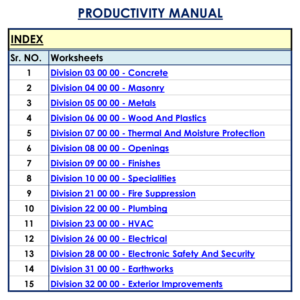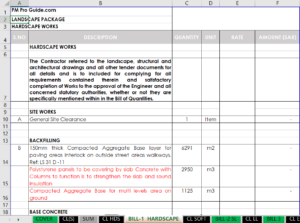In construction projects, there are many uncertainties and challenges that may arise, which can lead to changes in the scope of work or design. When these changes occur, a variation order is issued to formalize the changes and ensure that they are properly documented and executed. In this article, we will discuss the importance of variation orders in construction projects, their impact on the project, and how they can be effectively managed.
Table of Contents
Introduction
Construction projects are complex and involve many stakeholders, including clients, contractors, subcontractors, suppliers, and regulatory authorities. With so many moving parts, changes are bound to occur, whether due to unforeseen circumstances or changes in project requirements. These changes can have significant impacts on the project timeline, budget, and quality, making it essential to manage them effectively. In this context, variation orders play a crucial role.
What is a Variation Order?
A variation order is a formal document that outlines changes to the original scope of work, design, or contract terms in a construction project. It is issued by the client or the contractor, depending on who initiates the change, and outlines the changes to be made, the impact on the project timeline and budget, and any other relevant details. Variation orders must be approved by both parties and should be reflected in the project schedule and budget.
If you are interested in learning more about how to handle changes when a contractor does work without a change order, check out our guide on the topic here.
Why are Variation Orders Important?
Variation orders are important for several reasons, including:
– Ensuring Clarity and Consistency
Variation orders help to formalize changes to the project scope and ensure that everyone involved in the project is aware of the changes. They also provide a consistent method of documenting changes, making it easier to track changes and communicate them to stakeholders.
– Protecting Against Legal Claims
Variation orders help to protect both parties from legal claims by clearly defining the changes and the impact on the project timeline and budget. Without a variation order, changes could be interpreted differently by each party, leading to disputes and potential legal claims.
– Managing Project Risks
Variation orders can help to manage project risks by identifying and documenting changes that may impact the project timeline, budget, or quality. By having a clear understanding of the changes and their impact, project teams can proactively manage the risks associated with the changes.
Types of Variation Orders
There are two main types of variation orders:
– Client Initiated Variation Orders
Client initiated variation orders occur when the client requests a change to the project scope or design. These changes may be due to changes in project requirements, unforeseen circumstances, or other factors. In these cases, the client is responsible for issuing the variation order and approving any changes to the project timeline or budget.
– Contractor Initiated Variation Orders
Contractor initiated variation orders occur when the contractor identifies a change that is necessary to complete the project or improve project outcomes. These changes may be due to unforeseen circumstances, changes in project requirements, or other factors. In these cases, the contractor is responsible for issuing the variation order and obtaining approval from the client before implementing the changes.
Impact of Variation Orders
Variation orders can have significant impacts on the project timeline, budget, and quality. Some of the key impacts include:
– Time and Cost Implications
Changes to the project scope or design can
result in additional work, materials, or labor, which can increase the project timeline and budget. Without proper management and documentation, these changes can also lead to delays and cost overruns.
– Risk Management Implications
Variation orders can also impact project risks by introducing new risks or changing the likelihood or impact of existing risks. For example, a change to the project scope may introduce new safety risks or require additional resources to manage.
Managing Variation Orders
Managing variation orders effectively is critical to ensuring that the project is completed on time, within budget, and to the required quality. Some key elements of effective variation order management include:
– Change Management Process
A robust change management process is essential for managing variation orders effectively. This process should include clear procedures for identifying, assessing, and approving changes, as well as for updating the project schedule and budget.
– Documentation Requirements
Proper documentation of variation orders is critical for ensuring that changes are properly tracked and communicated to stakeholders. This documentation should include details such as the reason for the change, the impact on the project timeline and budget, and any other relevant information.
– Communication and Collaboration
Effective communication and collaboration are essential for managing variation orders. All stakeholders should be kept informed of changes and their impact, and there should be clear lines of communication for raising concerns or questions.
Best Practices for Variation Order Management
To effectively manage variation orders, some best practices include:
- Establishing a robust change management process that includes clear procedures for identifying, assessing, and approving changes.
- Ensuring that all changes are properly documented and communicated to stakeholders.
- Providing regular updates on the status of variation orders and their impact on the project timeline and budget.
- Encouraging open communication and collaboration between all stakeholders to identify potential changes and mitigate their impact.
- Incorporating lessons learned from previous variation orders to continuously improve the change management process.
Case Study: Variation Order in a Hospital Construction Project
– Background
ABC Construction Company is working on a new hospital construction project in a major city. The project has a total budget of $100 million and is scheduled to be completed in 24 months. The project includes a 10-story hospital building with 400 patient rooms, operating rooms, diagnostic imaging facilities, and other support areas.
– Variation Order
During the construction process, the hospital management team decided to add a new wing to the hospital building to accommodate additional patient rooms and support areas. This change required a variation order to be issued to ABC Construction Company. The variation order added an additional $10 million to the project budget and extended the project timeline by six months.
– Impacts of the Variation Order
The variation order had several impacts on the project:
- Budget: The project budget increased from $100 million to $110 million due to the variation order.
- Timeline: The project timeline was extended by six months to accommodate the additional work required for the new wing.
- Design: The design of the hospital building had to be modified to accommodate the new wing, which required additional design work and approval.
- Construction: The construction process had to be modified to accommodate the new wing, which required additional materials and labor.
– Risk Management Implications
The variation order also had implications for project risks:
- Safety: The addition of a new wing to the hospital building introduced new safety risks, such as ensuring proper ventilation and fire safety systems.
- Resource Management: The addition of a new wing required additional resources, such as materials and labor, which needed to be managed effectively to ensure that the project remained within budget and on schedule.
– Managing the Variation Order
To manage the variation order effectively, ABC Construction Company implemented the following steps:
- Change Management Process: ABC Construction Company followed a robust change management process that included clear procedures for identifying, assessing, and approving changes. This process ensured that the variation order was properly reviewed and approved before any work was started.
- Documentation Requirements: ABC Construction Company ensured that the variation order was properly documented, including details such as the reason for the change, the impact on the project timeline and budget, and any other relevant information. This documentation was shared with all stakeholders to ensure that everyone was aware of the changes.
- Communication and Collaboration: ABC Construction Company maintained open communication with the hospital management team to ensure that they were aware of the changes and their impact. They also collaborated with the design and construction teams to ensure that the new wing was integrated seamlessly into the overall hospital building design.
– Best Practices for Variation Order Management
ABC Construction Company followed several best practices for variation order management, including:
- Establishing a robust change management process that includes clear procedures for identifying, assessing, and approving changes.
- Ensuring that all changes are properly documented and communicated to stakeholders.
- Providing regular updates on the status of variation orders and their impact on the project timeline and budget.
- Encouraging open communication and collaboration between all stakeholders to identify potential changes and mitigate their impact.
- Incorporating lessons learned from previous variation orders to continuously improve the change management process.
Variation Order vs. Change Order

Variation order and change order are two terms that are often used interchangeably in the construction industry, but they actually refer to two different types of changes in a construction project.
A variation order is a change to the original scope of work that arises during the construction process. This change may be initiated by the owner or the contractor and can be due to a variety of reasons, such as design changes, unforeseen site conditions, or changes in regulations. Variation orders typically result in additional costs and/or time extensions to the project.
On the other hand, a change order is a written agreement between the owner and the contractor to modify the original contract scope, price, or schedule. Change orders may be initiated by either party and can be due to a variety of reasons, such as design errors, changes in regulations, or unforeseen site conditions. Unlike variation orders, change orders are negotiated and agreed upon before any work is performed.
While variation orders and change orders may seem similar, there are slight differences in how they are initiated, approved, and executed. Proper management of both types of changes is critical to the success of a construction project.
Change Log in Construction Projects
A change log is a document used to track changes to a project scope, schedule, or budget. It is an important tool for managing changes in a construction project and can help ensure that all stakeholders are aware of changes and their impact on the project.
A change log typically includes the following information:
- Date of change
- Description of change
- Reason for change
- Person responsible for change
- Impact on project scope, schedule, and/or budget
- Status of change (e.g. approved, pending, rejected)
Here is an example of a change log in a tabular form:
| Date of Change | Description of Change | Reason for Change | Person Responsible | Impact on Project | Status |
|---|---|---|---|---|---|
| 1/1/2023 | Additional electrical work required in Room 301 | Design error | Electrical Engineer | +$10,000, +1 week | Approved |
| 1/10/2023 | Change in HVAC ductwork routing | Owner request | HVAC Contractor | +$5,000 | Pending |
| 1/15/2023 | Change in flooring material for lobby | Design change | Architect | +$20,000 | Rejected |
The change log should be updated regularly and shared with all stakeholders to ensure that everyone is aware of changes and their impact on the project. By using a change log, construction project teams can effectively manage changes and minimize their impact on project outcomes.
Conclusion
Variation orders are an essential part of construction projects, as they help to formalize changes to the project scope, design, or contract terms. Effective management of variation orders is critical to ensuring that the project is completed on time, within budget, and to the required quality. By following best practices for variation order management, project teams can minimize the impact of changes and improve project outcomes.
FAQs
- What is the difference between a variation order and a change order? A variation order is a type of change order that specifically relates to changes in the project scope, design, or contract terms.
- Who is responsible for issuing a variation order? The party responsible for issuing a variation order depends on who initiates the change. If the change is initiated by the client, the client is responsible for issuing the variation order. If the change is initiated by the contractor, the contractor is responsible for issuing the variation order.
- Can variation orders impact project risks? Yes, variation orders can impact project risks by introducing new risks or changing the likelihood or impact of existing risks.
- What should be included in a variation order? A variation order should include details such as the reason for the change, the impact on the project timeline and budget, and any other relevant information.
- How can project teams manage variation orders effectively? Project teams can manage variation orders effectively by establishing a robust change management process, properly documenting all changes, and encouraging open communication and collaboration between all stakeholders.



























